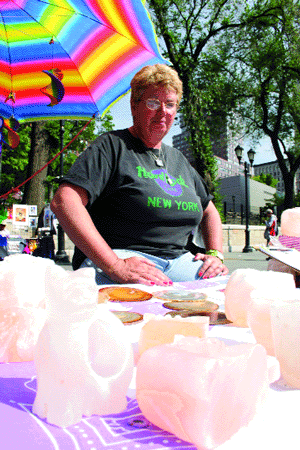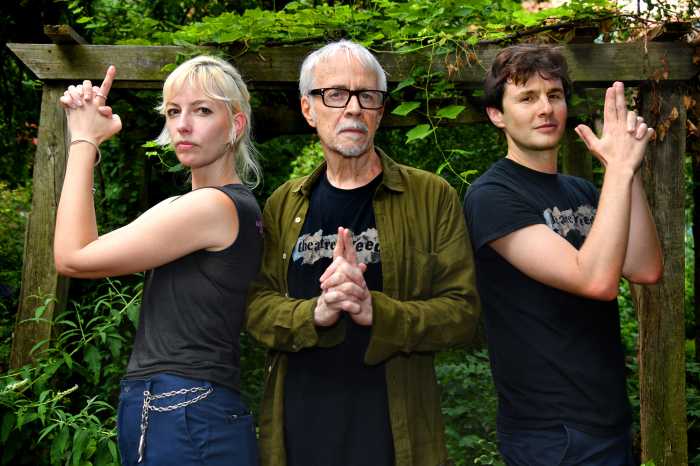By Lincoln Anderson
While retail stores are booming in Union Square, vending has also exploded in the park’s southern plaza, to the chagrin of some who think this space should be for tranquil strolling and passive recreation, as well as, perhaps, some very limited Hacky Sack kicking. Vendors have also proliferated on the south side of 14th St., causing bottlenecks on the sidewalk. But it’s in the park’s southern plaza where the war between vendors and those who would kick them out like an unwanted Hacky Sack is being waged. The plaza and the Gandhi statue garden were renovated and expanded, with a fountain added, a few years ago, but it’s unlikely the Parks Department’s intent was for it to become a bustling vendors’ mart.
Susan Kramer, co-chairperson of the resident’s group Union Square Community Coalition for the past five years, said, in her personal view, the situation has gotten out of hand. She refers to the park now as “Vendor Square Park.”
After Park Enforcement Patrol officers ticketed her for selling miniature artwork in tiny frames in Union Square Park, Miriam W. added political-content works, like this one, as well as religious-content works, to her collection. The PEP officers say she’s selling pins — basically, jewelry — but she maintains they’re tiny, hangable artworks.
“What was once a beautiful, open plaza, newly dedicated with a splashing fountain, has turned into what to me looks like a crowded flea market,” Kramer said. “Each season more and more vendors appear and I see nothing in the works to stop the whole park from being taken over by them, literally. I’ve counted more than 40 on a nice day.
“Some vendors appear to be selling material that is certainly questionable as to its being protected by the First Amendment, so the law is not being enforced, or there is not enough manpower to do the enforcing,” she added.
Kramer questioned why there hasn’t been as much outrage over the peddlers as about the hotly debated plan to turn the pavilion at the park’s north end into a seasonal restaurant.
“There are people in the community who are adamant that there be no commercial use of public space [in the park],” Kramer said. “I am truly puzzled and dismayed that not one of those people has jumped on vending as an issue that seems to me to fit squarely into that category.
“We want our open space back so we can gaze at Gandhi and the water spray of the fountain or just sit and people watch,” she said.
Kramer says she’s reached out for help on the vendors to the mayor’s office, the Parks Department, Councilmember Rosie Mendez and Council Speaker Christine Quinn, without much result. No one wants to be accused of trampling on First Amendment free-speech rights, she said.
Meanwhile, the vendors are digging in their heels and aren’t about to relinquish their lucrative turf. They have worked to fathom the intricacies of the city’s vending law, but say the Park Enforcement Police officers who sometimes hassle them either don’t fully understand the law or have been improperly instructed in it.
A pair of women known as the Two Susans have been vending in Union Square Park for more than a decade. They used to hold one of the city’s 853 vendors’ licenses, and for years sold handmade candles. They’d get the wax from a beekeeper who sold honey in the Greenmarket. However, after the city did away with vendors’ licenses in 1996 as a result of a court case, the Susans were told by a Parks official that candles were not protected because they’re not art, but functional.
“I spoke to [Assistant] Commissioner [Jack] Linn,” recalled one of the Susans. “He said, ‘If it has a purpose, you can’t sell it.’ ”
Partners in both life and business, the Susans now vend handcrafted rock-salt candle holders from Nepal, which apparently qualify as sculpture. Since making the switch, they haven’t had any problems.
But another vendor they knew who sold handmade soap left the square after she couldn’t convince a judge her soap was a craft.
Miniart, big confusion
Vending near the Two Susans by the Gandhi statue on a recent Wednesday afternoon, Miriam W. also hasn’t had it easy selling her miniartwork, which are made of her own paintings and photos, shrunken to fit inside metal miniframes. She declined to give her last name, noting, “They’re already after me.”
“They” are the Park Enforcement Patrol officers, one of whom gave her a $250 ticket for hawking her stamp-size art, feeling it was jewelry, which isn’t protected as expressive content under the First Amendment that can be sold on streets or in parks.
“I told him it was artwork. He said, ‘Artwork I don’t see — I only see pins,’ ” Miriam recalled. The Environmental Control Board judge who reviewed her ticket also saw things differently from her.
“The judge admitted it was artwork — but said because it has a loop on it, it’s jewelry,” Miriam said. But Miriam says the loop is so people can hang the miniart on the wall — or, yes, even wear it if they choose on a necklace or pinned to their shirt or blouse. “Even if this was jewelry, it has artwork in it,” Miriam explained. “I’m seeing it as my artwork first, jewelry second, and the judge is seeing it as jewelry first and artwork second.”
She’s contesting the ticket in court. Meanwhile, hoping to get the PEP’s off her back, she’s added framed, normal-size prints of her own photos and art to her table and also miniartworks of a political nature — with anti-Bush and antiwar logos, for example — and with religious content, such as a portrait of Ganesha, the Hindu elephant-headed god, and Judeo-Christian symbols, that she hopes will more clearly be recognized as First Amendment protected.
She plans to stay and isn’t going without a fight.
“I live in the neighborhood, it’s convenient [to vend in the park],” she said. “And I love the park.”
Robert Lederman, president of A.R.T.I.S.T., or Artists’ Response to Illegal State Tactics, won two federal court cases in 1996 and 2001 on vendors, one of which the city appealed all the way to the U.S. Supreme Court. The first verdict opened up the city’s streets to vendors of paintings, printed matter, photos or sculpture under First Amendment grounds of freedom of expression, without any permits being required. The second ruling did the same for vendors in the city’s parks.
Lederman says Miriam’s miniworks are definitely art.
“I don’t have the slightest question in my mind that she’s protected,” he said. “I’ve given her extensive counseling on how to deal with her case. I’ve encouraged her to file a lawsuit. She makes paintings and photos and makes them small. It’s an unlosable case. She made her art so that it’s more available to the public — it’s incidental to the expression.”
Yet, the argument over whether Miriam’s minipaintings are art or jewelry could become moot if legislation the Parks Department is reportedly drafting is passed. Parks would move aggressively to boot out many — if not all — vendors in city parks under the new legislation to be introduced soon in the City Council.
Warner Johnston, a Parks spokesperson, neither confirmed nor denied that the legislation is pending.
“I don’t have any information I can share with you at this point,” he said last week.
Parks’ ‘secret plan’
However, City Councilmember Alan Gerson said it was his understanding the Parks Department is, in fact, working on legislation to curb vendors in city parks. This legislation will be introduced by Mayor Bloomberg into the Council’s Parks Committee, Gerson said, adding he expects it to be heard in the fall. Gerson agrees something needs to be done.
“Battery Park has become more of a bazaar than a park” because of all the vendors, noted Gerson, who represents Lower Manhattan’s Council District 1. “Union Square is not in my district. But the principle should apply to all parks. Parks need to have space for passive and active recreation in a noncommercial environment. You still need space for expression and art. That’s why you need a sensible regulatory scheme.”
Gerson admitted, however, that a previous Parks bill on vendors “overstepped a bit.”
Lederman, though — who notes that he’s planning to file yet another lawsuit within the month — says to Parks “bring it on.” Lederman wouldn’t divulge the content of his upcoming lawsuit, but he claims the city is leery of the vendors now.
“The city is very afraid to mess with them because they’re afraid of another lawsuit,” Lederman said. He bragged he was praying that the city had tried to pass the last parks vendors bill, since he was relishing the opportunity to take it to the Supreme Court and defeat it.
As for the Parks Department, Lederman said, its real agenda isn’t about clearing space for pedestrians, but, rather, “They want to sell concessions for hundreds of thousands of dollars” to select vendors.
The city’s real fear is jewelry vendors, the A.R.T.I.S.T. leader contends. Currently, jewelry isn’t protected as a free-expression art form, as witnessed by the challenge Miriam W. is facing with the PEP’s charging her miniart is jewelry and thus illegal. If it were legal to sell jewelry on the street, the floodgates would open and vendors by the thousands would fill sidewalks and parks, Lederman, as well as others say. A $15 or $20 piece of jewelry is a quick and easy purchase for someone strolling through a vendors’ mart; vendors of artwork and other sculpture privately say they object to the presence of jewelry vendors nearby, feeling they siphon off their business.
However, Lederman said, “Jewelry is without question the earliest form of art. Probably the most popular form of jewelry in the world is what? — a crucifix. Can you argue that isn’t expressive?” But he said he won’t file a lawsuit to protect jewelry vending since he personally doesn’t make or sell jewelry but is an artist.
Henry Choi, a spokesperson for the Union Square Partnership business improvement district, said the BID is largely leaving the park vendors for the Parks Department to deal with.
“We will assist and patrol, but it’s not as much on our radar,” he said.
But vending has also grown across from the park on the south side of 14th St., where the BID does plan to crack down on vendors who are not selling expressive-content items.
“It’s an area of super-high congestion,” Choi said. “It’s almost become like Times Square. Since Whole Foods opened up last year, there’s been so much foot traffic it’s stressing the capacity of the sidewalk. People are being pushed out into the street.”





































